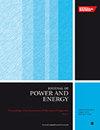不稳定流动结构对离心泵内能量传递机制的影响
IF 1.1
4区 工程技术
Q3 ENGINEERING, MECHANICAL
Proceedings of the Institution of Mechanical Engineers, Part A: Journal of Power and Energy
Pub Date : 2023-08-12
DOI:10.1177/09576509231195222
引用次数: 0
摘要
为了揭示离心泵的能量损失机理,通过数值模拟和实验研究,得到了不同流动条件下单级离心泵的复杂流场。重点对泵模型中不可逆损失的分布和变化特征进行了定性和定量分析。结果表明:离心泵内的能量损失主要来自于紊流耗散和壁面摩擦引起的熵产,主要发生在蜗壳和叶轮区域;值得注意的是,蜗壳内的能量损失与叶轮出口的非均匀速度分布和脱落涡的演变密切相关,而叶轮内的能量损失则受到流动分离、回流和射流尾迹等不稳定流动现象的极大影响。在过载工况下,壁面熵产对能量损失有较大影响,主要与壁面剪应力有关。同时,随着流量的增加,动静相互作用和来流对能量损失的影响也随之增强。最后,omega方法捕获了局部流动条件下舌部附近的涡度结构,从而揭示了高强度流动损失与不同尺度强涡度片的演变之间的关系。本文章由计算机程序翻译,如有差异,请以英文原文为准。
Effects of unstable flow structures on energy transfer mechanism in a centrifugal pump
To reveal the energy loss mechanism of the centrifugal pump, numerical simulation and experimental investigation are conducted to obtain the complex flow field of a single-stage centrifugal pump under various flow conditions. Particular emphasis is focused on the qualitative and quantitative analysis of the distribution and variation characteristics of irreversible loss in the pump model. The results show that the energy loss in the centrifugal pump mainly originates from the entropy generation caused by the turbulent dissipation and wall friction, which are typically generated in the volute and impeller domains. It is worth noticing that the energy loss in the volute is closely associated with non-uniform velocity distribution and the evolution of the shedding vortices from the impeller exit whilst the energy loss in the impeller are greatly affected by unstable flow phenomena such as flow separation, backflow, and jet-wake pattern. At the overload operating conditions, the wall entropy generation possesses a substantial influence on energy loss, which is mainly related to the wall shear stress. Meanwhile, the influence of the rotor-stator interaction and inflow impacting on the energy loss is enhanced with increasing flows. Finally, the omega method captured the vorticity structures near the tongue at partial flow conditions, thereby, revealing the relationship between the high magnitude of flow loss and the evolution of different scales of strong vorticity sheets.
求助全文
通过发布文献求助,成功后即可免费获取论文全文。
去求助
来源期刊

CiteScore
3.30
自引率
5.90%
发文量
114
审稿时长
5.4 months
期刊介绍:
The Journal of Power and Energy, Part A of the Proceedings of the Institution of Mechanical Engineers, is dedicated to publishing peer-reviewed papers of high scientific quality on all aspects of the technology of energy conversion systems.
 求助内容:
求助内容: 应助结果提醒方式:
应助结果提醒方式:


